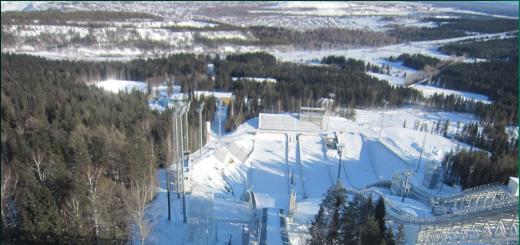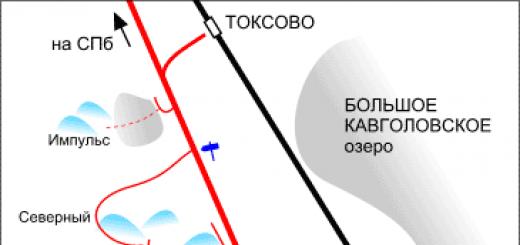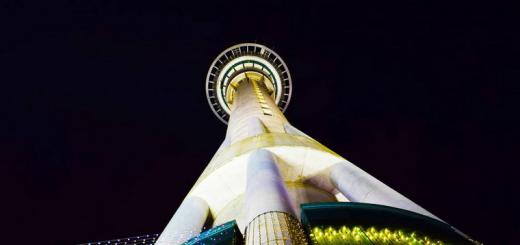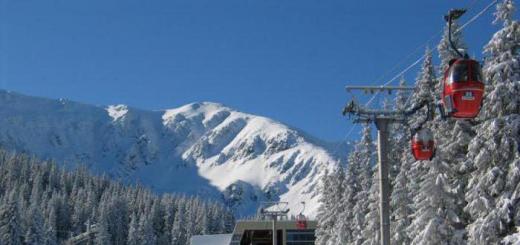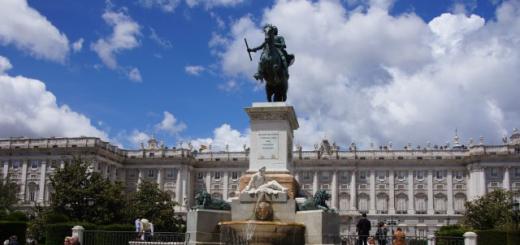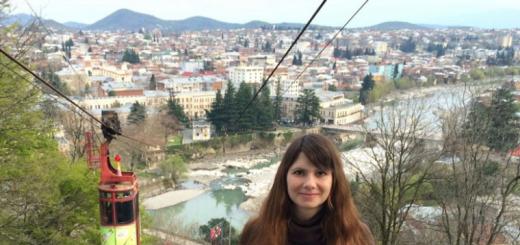The Caspian is simultaneously considered both an endless lake and a full-fledged sea. The confusion stems from brackish waters and a marine-like hydrological regime.
The Caspian Sea is located on the border of Asia and Europe. Its area is about 370 thousand km 2, the maximum depth is just over one kilometer. The Caspian is conditionally divided into three almost equal parts: South (39% of the area), Middle (36%) and North (25%).
The sea washes simultaneously the Russian, Kazakh, Azerbaijani, Turkmen and Iranian shores.
Shore of the Caspian Sea(Caspian region) is about 7 thousand kilometers long, if you count together with the islands. In the north, the low seashore is covered with swamps and thickets, and has multiple water channels. Eastern and West Coast The Caspian Sea has a winding shape, in some places the shores are covered with limestone.
There are many islands in the Caspian: Dash-Zira, Kyur Dashi, Dzhambaysky, Boyuk-Zira, Gum, Chigil, Khere-Zira, Zenbil, Ogurchinsky, Tyuleniy, Ashur-Ada, etc. Peninsulas: Mangyshlak, Tyub-Karagan, Apsheronsky and Miankale. Their total area is approximately 400 km 2.
It flows into the Caspian Sea more than a hundred different rivers, the most significant are the Ural, Terek, Volga, Atrek, Emba, Samur. Almost all of them provide the sea with 85–95% of the annual drainage.
The largest bays of the Caspian: Kaidak, Agrakhan, Kazakh, Dead Kultuk, Turkmenbashi, Mangyshlak, Gyzlar, Girkan, Kaidak.

Caspian climate
The Caspian Sea is located in three climatic zones at once: subtropical climate in the south, continental in the north and temperate in the middle. In winter average temperature varies from -10 to +10 degrees, while in summer the air warms up to about +25 degrees. During the year, precipitation falls from 110 mm in the east and up to 1500 mm in the west.
The average wind speed is 3‒7 m / s, but in autumn and winter it often increases to 35 m / s. The most drained areas are the coastal areas of Makhachkala, Derbent and the Absheron Peninsula.
Caspian Sea water temperature ranges from zero to +10 degrees in winter, and from 23 to 28 degrees in the summer months. In some coastal shallow waters, the water can warm up to 35-40 degrees.
Only the northern part of the sea is subject to freezing, but in especially cold winters, the coastal zones of the middle part are added to it. The ice cover appears in November and disappears only in March.

Problems of the Caspian Region
Water pollution is one of the main environmental problems of the Caspian. Oil production, various harmful substances from flowing rivers, waste from nearby cities - all this negatively affects the state of sea water. Additional troubles are created by poachers, whose actions reduce the number of fish of certain species found in the Caspian Sea.
Sea level rise is also causing serious financial damage to all the Caspian countries.
According to conservative estimates, the restoration of destroyed buildings and the implementation of comprehensive measures to protect the coast from flooding cost tens of millions of dollars.

Cities and resorts on the Caspian Sea
The most big city and the port washed by the waters of the Caspian Sea is Baku. Among the others settlements Azerbaijan, located in close proximity to the sea, are Sumgait and Lankaran. On the eastern shores there is the city of Turkmenbashi, and about ten kilometers from it, by the sea, is the large Turkmen resort of Avaza.
From the Russian side to seashore the following cities are located: Makhachkala, Izberbash, Derbent, Lagan and Kaspiysk. Astrakhan is often called a port city, although it is located about 65 kilometers from the northern shores of the Caspian Sea.

Astrakhan
Beach recreation in this region is not provided: along the sea coast there are only continuous reed thickets. However, tourists go to Astrakhan not for idle lying on the beach, but for fishing and various types active rest: diving, catamarans, jet skis, etc. In July and August, excursion ships run across the Caspian Sea.

Dagestan
For a classic seaside vacation, it is better to go to Makhachkala, Kaspiysk or Izberbash - this is where not only good sandy beaches, but also a worthy recreation center. The range of entertainment on the seashore from the Dagestan side is quite wide: swimming, therapeutic mud springs, windsurfing, kiting, rock climbing and paragliding.
The only drawback of this area is the underdeveloped infrastructure.
In addition, among some Russian tourists there is an opinion that Dagestan is far from the most peaceful territory that is part of the North Caucasian Federal District.

Kazakhstan
A much calmer environment can be found in the Kazakh resorts of Kuryk, Atyrau and Aktau. The latter is the most popular tourist town Kazakhstan: there are many good entertainment facilities and comfortable beaches. In the summer it is very heat, reaching +40 degrees in the daytime, and dropping only to +30 at night.
Disadvantages of Kazakhstan as tourist country- the same bad infrastructure and rudimentary transport connection between regions.

Azerbaijan
The most the best places for recreation on the coast of the Caspian Sea are considered Baku, Nabran, Lankaran and other Azerbaijani resorts. Fortunately, everything is fine with the infrastructure in this country: for example, in the area of the Absheron Peninsula, several modern comfortable hotels with swimming pools and beaches have been built.
However, in order to enjoy a vacation on the Caspian Sea in Azerbaijan, you need to spend a lot of money. In addition, it is possible to get to Baku quite quickly only by plane - trains rarely run, and the journey from Russia itself takes two or three days.
Tourists should not forget that Dagestan and Azerbaijan are Islamic countries, so all "unbelievers" need to adjust their usual behavior to local customs.
If you follow the simple rules of stay, nothing will spoil your vacation on the Caspian Sea.
The Caspian Sea is the largest enclosed body of water on planet Earth, located on the continent of Eurasia - in border area states Russia, Kazakhstan, Turkmenistan, Iran and Azerbaijan. In fact, it is a giant lake left after the disappearance of the ancient Tethys ocean. Nevertheless, there is every reason to consider it as an independent sea (this is indicated by salinity, large area and decent depth, the bottom of the oceanic crust and other signs). In terms of maximum depth, it is the third among closed bodies of water - after lakes Baikal and Tanganyika. In the northern part of the Caspian Sea (a few kilometers from the northern coast - parallel to it) passes geographic boundary between Europe and Asia.
Toponymy
- Other names: throughout the history of mankind, the Caspian Sea had about 70 different names among different peoples. The most famous of them: Khvalynskoe or Khvalisskoe (took place during the time of Ancient Russia, arose by the name of the people praises who lived in the Northern Caspian Sea and traded with the Russians), Girkanskoe or Dzhurdzhanskoe (derived from the alternative names of the city of Gorgan, located in Iran), Khazar, Abeskunskoe (by the name of the island and the city in the Kura delta - now flooded), Saraisk, Derbent, Sihai ...
- Origin of name: according to one hypothesis, its modern and most ancient name, The Caspian Sea received from a tribe of nomadic horse breeders Kaspiev living in 1st millennium BC on the southwest coast.
Morphometry
- Drainage area: 3,626,000 km².
- Mirror area: 371,000 km².
- Coastline length: 7,000 km
- Volume: 78 200 km³.
- Average depth: 208 m.
- Maximum depth: 1,025 m.
Hydrology
- The presence of a constant flow: no, drainless.
- Inflows:, Ural, Emba, Atrek, Gorgan, Heraz, Sefidrud, Astarchay, Kura, Pirsagat, Kusarchay, Samur, Rubas, Darvagchay, Uluchay, Shuraozen, Sulak, Terek, Kuma.
- Bottom: very diverse. At shallow depths, sandy soil with an admixture of shells is common, in deep-water places it is silty. Pebble and rocky places can be found in the coastal strip (especially where mountain ranges adjoin the sea). In the estuarine areas, the underwater soil consists of river sediments. The Kara-Bogaz-Gol bay is notable for the fact that its bottom is a thick layer of mineral salts.
Chemical composition
- Water: brackish.
- Salinity: 13 g / l.
- Transparency: 15 m.
Geography

Fig. 1. Map of the Caspian Sea Basin.
- Coordinates: 41 ° 59′02 ″ s. sh., 51 ° 03'52 ″ in. etc.
- Height above sea level:-28 m.
- Coastal landscape: due to the fact that the coastline of the Caspian Sea is very long, and it itself is located in different geographic zones, the coastal landscape is diverse. In the northern part of the reservoir, the shores are low, swampy, in places of the deltas of large rivers cut by numerous channels. The eastern shores are mostly limestone - desert or semi-desert. Western and south coast adjoin mountain ranges. The most indented coastline is observed in the west - in the area of the Apsheron Peninsula, as well as in the east - in the area of the Kazakh and Kara-Bogaz-Gol bays.
- Settlements on the banks:
- Russia: Astrakhan, Derbent, Kaspiysk, Makhachkala, Olya.
- Kazakhstan: Aktau, Atyrau, Kuryk, Sogandyk, Bautino.
- Turkmenistan: Ekerem, Karabogaz, Turkmenbashi, Khazar.
- Iran: Astara, Balboser, Bandar-Torkemen, Bandar-Anzali, Neka, Chalus.
- Azerbaijan: Alat, Astara, Baku, Dubendi, Lankaran, Sangachaly, Sumgayit.
Interactive map
Ecology
The ecological situation in the Caspian Sea is far from ideal. Practically all large rivers flowing into it are polluted by wastewater from industrial enterprises located upstream. This could not but affect the presence of pollutants in the waters and bottom sediments of the Caspian - over the past half century, their concentration has significantly increased, and the content of some heavy metals has already exceeded the permissible limits.
In addition, the waters of the Caspian Sea are constantly polluted by domestic wastewater from coastal cities, as well as during oil production on the continental shelf, and during its transportation.
Fishing in the Caspian Sea
- Fish species:
- Artificial settlement: not all of the above fish species in the Caspian Sea are indigenous. About 4 dozen species were caught by accident (for example, through the channels from the Black and Baltic seas), or were deliberately inhabited by humans. An example is mullet. Three Black Sea species of these fish - striped mullet, ostronos and singil - were released in the first half of the 20th century. Loban did not take root, but the ostronos with the singil have successfully acclimatized, and by now they have settled practically throughout the entire water area of the Caspian, having formed several commercial herds. At the same time, the fish feed faster than in the Black Sea, and reach larger sizes. In the second half of the last century (since 1962), attempts were also made to settle in the Caspian Sea such Far Eastern salmon fishes as pink salmon and chum salmon. In total, several billion fry of these fish were released into the sea for 5 years. Pink salmon did not survive in the new habitat, chum salmon, on the contrary, successfully took root and even began to spawn in the rivers flowing into the sea. However, she could not reproduce in sufficient numbers and gradually disappeared. So far, there are no favorable conditions for its full-fledged natural reproduction (there are very few places where spawning and development of fry could successfully occur). To ensure them, reclamation of rivers is needed, otherwise, without human help (artificial sampling of eggs and its incubation), the fish will not be able to maintain their numbers.
Fishing spots
In fact, fishing is possible anywhere along the coast of the Caspian Sea, which can be reached by land or water. What species of fish will be caught at the same time depends on local conditions, but to a greater extent on whether rivers flow here. As a rule, in places where estuaries and deltas are located (especially large watercourses), the water in the sea is strongly desalinated, therefore freshwater fish (carp, catfish, bream, etc.) usually prevail in catches, and species characteristic of flowing rivers (barbel, shemaya). Of the marine species in desalinated areas, those for which salinity does not matter (mullet, some of the gobies) are caught. In certain periods of the year, semi-anadromous and anadromous species can be found here, feeding in the sea, and spawning in rivers (sturgeon, some of herring, Caspian salmon). In places where there are no rivers flowing in, freshwater species are found in slightly smaller numbers, but at the same time marine fish appear, usually avoiding desalinated areas (for example - sea pike perch). Far from the coast, fish are caught, preferring salt water, and deep sea views.
Conventionally, there are 9 places or sites that are interesting in terms of fishing:
- North Shore (RF)- this site is located on the northern coast of the Russian Federation (from the Volga delta to the Kizlyar Bay). Its main features are insignificant salinity of water (the lowest in the Caspian Sea), shallow depth, the presence of multiple shoals, islands, highly developed aquatic vegetation. In addition to the Volga delta with its numerous channels, bays and eriks, it also includes the near-estuarine seashore, called the Caspian peals. These places are popular with Russian fishermen, and for good reason: the conditions for fish are very favorable here, and there is also a good food base. The ichthyofauna in these parts may not be distinguished by the richness of species, but it is distinguished by its multiplicity, and its individual representatives reach very considerable sizes. Typically, the main catches are freshwater fish typical for the Volga basin. Most often caught: perch, pike perch, roach (more precisely, its varieties, called roach and ram), rudd, asp, sabrefish, bream, goldfish, carp, catfish, pike. Bersh, silver bream, white-eyed, blue bream are somewhat less common. Representatives of sturgeon (sturgeon, stellate sturgeon, beluga, etc.), salmon (nelma, brown trout - Caspian salmon) are also found in these places, but their catch is prohibited.
- Northwest coast (RF)- this section covers the west coast Russian Federation(from Kizlyar Bay to Makhachkala). The rivers Kuma, Terek and Sulak flow here - they carry their waters both along natural channels and artificial canals. There are bays in this area, some of which are quite large (Kizlyarsky, Agrakhansky). The sea in these places is shallow. Of the fish, freshwater fish predominate in the catches: pike, perch, carp, catfish, rudd, bream, barbel, etc., sea species are also caught here, for example, herring (black-backed, pusanok).
- West Bank (RF)- from Makhachkala to the border of the Russian Federation with Azerbaijan. A site where mountain ranges adjoin the sea. The salinity of the water here is slightly higher than in previous places, therefore, in the catches of fishermen, marine species are more common (sea pike perch, mullet, herring). However, freshwater fish are by no means uncommon.
- West Bank (Azerbaijan)- from the border of the Russian Federation with Azerbaijan along the Absheron Peninsula. Continuation of the site, where mountain ranges adjoin the sea. Fishing here is even more like a typical sea one, thanks to fish such as ostronos and singil (mullet) and several species of gobies, which are also caught here. In addition to them, there are kutum, herring, and some typically freshwater species, for example, the carp.
- Southwest coast (Azerbaijan)- from the Absheron Peninsula to the border of Azerbaijan with Iran. Most of this site is occupied by the Kura River delta. The same fish species that were listed in the previous paragraph are caught here, but freshwater fish are more often caught.
- North coast (Kazakhstan)- this section covers the northern coast of Kazakhstan. The Ural delta and state reserve"Akzhaiyk", therefore, fishing directly in the river delta and in some adjacent water area is prohibited. Fishing is possible only outside the reserve - upstream of the delta, or in the sea - at some distance from it. Fishing near the Ural delta has much in common with fishing at the confluence of the Volga - almost the same species of fish are found here.
- North-east coast (Kazakhstan)- from the mouth of the Emba to Cape Tyub-Karagan. In contrast to the northern part of the sea, where the water is greatly diluted by the large rivers flowing into it, its salinity somewhat increases here, therefore those species of fish appear that avoid freshened areas, for example, sea pike perch, which is caught in the Dead Kultuk Bay. Other representatives of the marine fauna are also often found in the catches.
- East coast (Kazakhstan, Turkmenistan)- from Cape Tyub-Karagan to the border of Turkmenistan and Iran. Differs in almost complete absence of flowing rivers. The salinity of the water is at its maximum here. Of the fish in these places, marine species predominate, the main catch is mullet, sea pike perch and gobies.
- South Coast (Iran)- covers the southern coast of the Caspian. Throughout this section, the sea is adjacent to mountain range Elburs. Many rivers flow here, most of which are represented by shallow streams, there are also several medium and one large river... Among fish, in addition to marine species, there are also some freshwater, as well as semi-anadromous and anadromous species, for example, sturgeon.
Fishing features
The most popular and catchy amateur tackle, which is used on the Caspian coast, is a heavy spinning rod converted into a "sea donkey". Usually it is equipped with a strong reel, on which a rather thick line (0.3 mm and more) is wound. The thickness of the line is determined not so much by the size of the fish as by the mass of a rather heavy sinker, which is necessary for ultra-long casting (in the Caspian it is generally believed that the further from the coast the casting point is, the better). After the sinker, there is a thinner line - with several leads. Shrimps and amphipods that live in coastal thickets of algae are used as a bait - if you intend to fish for sea fish, or an ordinary bait like a worm, May beetle larvae and others - if freshwater species are found in the fishing area.
, Kazakhstan, Turkmenistan, Iran, Azerbaijan
Geographical position

Caspian Sea - view from space.
The Caspian Sea is located at the junction of two parts of the Eurasian continent - Europe and Asia. The length of the Caspian Sea from north to south is about 1200 kilometers (36 ° 34 "-47 ° 13" N), from west to east - from 195 to 435 kilometers, on average 310-320 kilometers (46 ° -56 ° c. d.).
The Caspian Sea is conventionally divided by physical and geographical conditions into 3 parts - the North Caspian, the Middle Caspian and the South Caspian. The conditional border between the North and Middle Caspian runs along the line about. Chechnya - Cape Tyub-Karagan, between the Middle and South Caspian - along the line of about. Residential - Cape Gan-Gulu. The area of the North, Middle and South Caspian is 25, 36, 39 percent, respectively.
Caspian Sea coast

Coast of the Caspian Sea in Turkmenistan
The territory adjacent to the Caspian Sea is called the Caspian region.
Peninsulas of the Caspian Sea
- Ashur-Ada
- Garasu
- Zyanbil
- Hara-Zira
- Sengi-Mugan
- Chygyl
Bays of the Caspian Sea
- Russia (Dagestan, Kalmykia and Astrakhan region) - in the west and north-west, the length of the coastline is about 1930 kilometers
- Kazakhstan - in the north, north-east and east, the length of the coastline is about 2320 kilometers
- Turkmenistan - in the southeast, the length of the coastline is about 650 kilometers
- Iran - in the south, the length of the coastline is about 1000 kilometers
- Azerbaijan - in the south-west, the length of the coastline is about 800 kilometers
Cities on the coast of the Caspian Sea
On the Russian coast there are cities - Lagan, Makhachkala, Kaspiysk, Izberbash and the most Southern City Russia Derbent. Astrakhan is also considered the port city of the Caspian Sea, which, however, is not located on the shores of the Caspian Sea, but in the Volga delta, 60 kilometers from north coast The Caspian Sea.
Physiography
Area, depth, volume of water
The area and volume of water in the Caspian Sea varies significantly depending on fluctuations in water level. With a water level of -26.75 m, the area is approximately 371,000 square kilometers, the volume of water is 78,648 cubic kilometers, which is approximately 44% of the world's lake water reserves. The maximum depth of the Caspian Sea is in the South Caspian depression, 1025 meters from its surface. In terms of maximum depth, the Caspian Sea is second only to Baikal (1620 m) and Tanganyika (1435 m). The average depth of the Caspian Sea, calculated according to the bathygraphic curve, is 208 meters. At the same time, the northern part of the Caspian is shallow, its maximum depth does not exceed 25 meters, and the average depth is 4 meters.
Water level fluctuations
Vegetable world
The flora of the Caspian Sea and its coast is represented by 728 species. Of the plants in the Caspian Sea, algae predominate - blue-green, diatoms, red, brown, charovy and others, from flowering plants - zostera and ruppia. By origin, the flora belongs mainly to the Neogene age, however, some plants were introduced into the Caspian Sea by humans deliberately or on the bottoms of ships.
History of the Caspian Sea
Origin of the Caspian Sea
Anthropological and cultural history of the Caspian Sea
Finds in the Huto y cave south coast The Caspian Sea testifies that people lived in these parts about 75 thousand years ago. The first mentions of the Caspian Sea and tribes living on its coast are found at Herodotus. Around the V-II centuries. BC e. the tribes of the Saks lived on the coast of the Caspian. Later, during the period of the settlement of the Turks, during the IV-V centuries. n. e. Talysh tribes (Talysh) lived here. According to ancient Armenian and Iranian manuscripts, Russians sailed in the Caspian Sea from the 9th-10th centuries.
Exploration of the Caspian Sea
The exploration of the Caspian Sea was started by Peter the Great, when, on his order, in 1714-1715, an expedition was organized under the leadership of A. Bekovich-Cherkassky. In the 1720s, hydrographic research was continued by the expedition of Karl von Verden and F.I.Soimonov, and later by I.V. Tokmachev, M.I.Voinovich and other researchers. At the beginning of the 19th century, instrumental survey of the banks was carried out by I.F.Kolodkin, in the middle of the 19th century. - instrumental geographic survey under the direction of N. A. Ivashintsev. Since 1866, for more than 50 years, expeditionary studies on the hydrology and hydrobiology of the Caspian have been conducted under the leadership of N.M. Knipovich. In 1897, the Astrakhan Research Station was founded. In the first decades of Soviet power in the Caspian Sea, geological research by I.M.Gubkin and other Soviet geologists was actively carried out, mainly aimed at finding oil, as well as research on the study of the water balance and fluctuations in the level of the Caspian Sea.
Economy of the Caspian Sea
Mining of oil and gas
Many oil and gas fields are being developed in the Caspian Sea. The proven oil resources in the Caspian Sea are about 10 billion tons, the total oil and gas condensate resources are estimated at 18-20 billion tons.
Oil production in the Caspian Sea began in 1820, when the first oil well was drilled on the Absheron shelf near Baku. In the second half of the 19th century, oil production began in industrial volumes on the Absheron Peninsula, then in other territories.
Shipping
Shipping is well developed in the Caspian Sea. Ferry services operate on the Caspian Sea, in particular, Baku - Turkmenbashi, Baku - Aktau, Makhachkala - Aktau. The Caspian Sea has a navigable connection with the Sea of Azov through the Volga, Don and Volga-Don Canal.
Fishing and seafood production
The aim of the Convention is “to protect the marine environment of the Caspian Sea from pollution, including protection, conservation, restoration, sustainable and rational use of its biological resources”. The convention entered into force on 12 August 2006.
Security concerns
The head of the strategic planning service of the Association for Border Cooperation (Moscow), Russian political expert Alexander Sobyanin believes that security in the Caspian and guarantees of sea neutrality will be observed only if the Russian fleet dominates it.
He noted in an interview with the SalamNews news agency: “A delicate balance and the absence of war are possible only and exclusively with the overwhelming superiority of one country - Russia. Any step towards bringing the capabilities of the flotillas of other countries closer to the capabilities of the Caspian Flotilla will upset the unstable balance and increase the possibility of military action. This task is still being fulfilled - the capabilities of the Caspian military flotilla [of Russia] exceed the aggregate capabilities of the flotillas of the other Caspian countries "
Caspian Sea short description an endless salt lake of Eurasia and the largest lake on the planet is described in this article. A message about the Caspian Sea will help you prepare for your studies.
Caspian Sea: report
This water body is located at the geographic junction of Europe and Asia. The water level is 28 m below sea level. During its long history, the Caspian Sea has "changed" more than 70 names. And his modern name it received from the ancient tribe of the Caspians, who were engaged in horse breeding and settled along the southwestern shore of the lake.
Salinity of the Caspian Sea not constant: near the mouth of the Volga River, it is 0.05%, and in the southeast, the figure increases to 13%. The area of the water body today is about 371,000 km 2, the maximum depth of the Caspian Sea is 1025 m.
Features of the Caspian Sea
Scientists conditionally divided the lake-sea into 3 natural zones:
- Northern
- Middle
- Southern
Each of them has a different depth and composition of water. For example, the smallest part is North. The full-flowing Volga River flows here, therefore the salinity is the lowest here. And the southern part is the deepest, and, accordingly, salty.
The Caspian Sea was formed more than 10 million years ago. It can be called part of the ancient Tethys superocean, which once ran between the African, Indian and Eurasian continental plates. Its long history is also evidenced by the nature of the bottom and geological coastal deposits. The length of the coastline is 6500 - 6700 km, and taking into account the islands up to 7000 km.
The shores of the Caspian are mostly smooth and low-lying. The northern part of the coastline is cut by islands and channels of the Ural and Volga delta. The coast is swampy and low, covered with thickets. The east coast is characterized by limestone shores that adjoin deserts and semi-deserts. The west and east coasts have winding shores.
Where does the Caspian Sea flow?
Since the Caspian is a closed body of water, it is logical that it does not flow anywhere. But 130 rivers flow into it. The largest of them are Terek, Volga, Emba, Ural, Kura, Atrek, Samur.
Caspian climate
The climate is continental in the northern part of the sea, temperate in the middle and subtropical in the southern part. In winter, the average temperature ranges from - 8 ... - 10 (northern part) to +8 ... + 10 (southern part). The average summer temperature ranges from +24 (northern part) to +27 (southern part). On the east coast the maximum temperature was recorded - 44 degrees.
Fauna and flora
The fauna is diverse and has 1809 species. There are 415 invertebrates and 101 fish species in the sea. It contains most of the world's reserves of pike perch, sturgeon, roach, carp. The Caspian Sea is home to carp, mullet, bream, sprat, perch, kutum, pike, as well as such a large mammal as the Caspian seal.
The flora is represented by 728 species. The sea is dominated by diatoms, brown algae, red algae, blue-green algae, chara algae, ruppia and zostera.
The importance of the Caspian Sea
There are many gas and oil reserves on its territory, the deposits of which are at the development stage. Scientists have calculated that oil resources amount to 10 billion tons, and gas condensate - 20 billion tons. The first oil well was drilled in 1820 on the Absheron shelf. Limestone, sand, salt, stone and clay are also mined on its shelf.
In addition, the Caspian Sea is popular with tourists. Modern resort zones are being created on its shores, mineral water and dirt is conducive to development wellness complexes and sanatoriums. The most famous resorts are Amburan, Nardaran, Zagulba, Bilgah.
Environmental problems of the Caspian Sea
The waters of the sea are polluted as a result of the production and transportation of gas and oil on the shelf. Also, pollutants come from rivers flowing into it. Poaching of sturgeon caviar led to a decrease in the number of these fish.
We hope that the report on the Caspian Sea helped you prepare for the lesson. And you can add an essay on the Caspian Sea through the comment form below.
Many geographical names can mislead people who are not interested in geography. Could it be that an object marked on all maps as the sea is in fact a lake? Let's figure it out.
The history of the emergence of the Caspian Sea?
The Sarmatian Sea existed on the planet 14,000,000 years ago. It consisted of modern, Black, Caspian and Azov sea... About 6,000,000 years ago, due to the rise of the Caucasus mountains and the lowering of the water level in the Mediterranean Sea, it split to form four different seas.
The Caspian is inhabited by many representatives of the Azov fauna, which once again confirms that once these reservoirs were one. This is one of the reasons why the Caspian Sea is considered a lake.
The name of the sea comes from the ancient tribes of the Caspians. They inhabited its shores in the first millennia BC and were engaged in horse breeding. But over the long hundreds of years of its existence, this sea bore many names. It was called Derbent, Saraysk, Girkansky, Sigai, Kukkuz. Even in our time, for the inhabitants of Iran and Azerbaijan, this lake is called the Khazar lake.
Geographic location
Two parts of the world - Europe and Asia, are washed by the waters of the Caspian Sea. The coastline covers the following countries:
- Turkmenistan
- Russia
- Azerbaijan
- Kazakhstan
The length from north to south is about one thousand two hundred kilometers, the width from west to east is about three hundred kilometers. The average depth is about two hundred meters, the maximum depth is about a thousand kilometers. The total area of the reservoir is over 370,000 square kilometers and is divided into three climatic and geographical zones:
- Northern
- Middle
- South Caspian
The water area has six large peninsulas and about fifty islands. Their total area is four hundred square kilometers. Most large islands- Dzhambayskiy, Ogurchinskiy, Chechenya, Tyuleniy, Konevskiy, Zyudev and Absheron Islands. About one hundred and thirty rivers flow into the Caspian, including the Volga, Ural, Atrek, Sefirud, Terek, Kura and many others.
Sea or lake?
The official name used in documentation and cartography is Caspian Sea. But is this true?
In order to be entitled to be called a sea, any body of water must be connected to the world's oceans. In the case of the Caspian, this is not the reality. The Caspian Sea is separated by almost 500 km of land from the nearest sea, the Black Sea. This is a completely enclosed body of water. The main differences between the seas:
- The seas can be fed by waterways - rivers.
- The outer seas are directly connected to the ocean, that is, they have access to it.
- The inland seas are connected with other seas or the ocean by straits.
The Caspian got the right to be called a sea, first of all, because of its impressive size, which is more characteristic of seas than lakes. In terms of area, it surpasses even the Azov one. Also, not a small role was played by the fact that not a single lake washes the shores of five states at once.
It should be noted that the structure of the bottom of the Caspian Sea belongs to the oceanic type. This happened due to the fact that it was once part of the ancient World Ocean.
Compared to other seas, the percentage of salt saturation in it is very low and does not exceed 0.05%. The Caspian is fed only by rivers flowing into it, like all lakes on the globe.
Like many seas, the Caspian is famous for its powerful storms. The wave height can reach eleven meters. Storms can take place at any time of the year, but they are most dangerous in autumn and winter.
In fact, the Caspian Sea is the most big lake in the world. Its waters are not subject to international maritime laws. The territory of the waters is divided between countries on the basis of laws adopted for lakes, not seas.
The Caspian Sea has rich mineral resources such as oil and gas. Its waters are inhabited by over one hundred and twenty species of fish. Among them are the most valuable sturgeon, such as stellate sturgeon, sturgeon, sterlet, beluga, thorn. 90% of the world sturgeon catch is in the Caspian Sea.
Interesting features:
- Scientists all over the world have not come to an unambiguous opinion why the Caspian Sea is considered a lake. Some experts even propose to consider it a "lake-sea" or "inland" sea, like the Dead Sea in Israel;
- The most deep point The Caspian Sea - more than one kilometer;
- Historically, it is known that the total water level in a reservoir has changed more than once. The exact reasons for this have not yet been studied;
- It is the only body of water separating Asia and Europe;
- The largest waterway feeding the lake is the Volga River. It is she who carries the bulk of the water;
- Thousands of years ago, the Caspian Sea was part of the Black Sea;
- In terms of the number of fish species, the Caspian Sea is inferior to some rivers;
- The Caspian Sea is the main supplier of the most expensive delicacy - black caviar;
- The water in the lake is completely renewed every two hundred and fifty years;
- Territory of Japan less area the Caspian Sea.
Ecological situation
Interference with the ecology of the Caspian Sea regularly occurs due to the extraction of oil and natural resources. There are also interventions in the fauna of the reservoir, there are frequent cases of poaching and illegal fishing of valuable fish species.
The water level in the Caspian Sea is falling every year. This is due to global warming, due to the influence of which the water temperature on the surface of the reservoir increased by one degree and the sea began to actively evaporate.
It is estimated that the water level has dropped by seven centimeters since 1996. By 2015, the level of the fall was about one and a half meters, and the water continues to fall.
If this continues further, in a century the smallest part of the lake may simply disappear. This will be the part that washes the borders of Russia and Kazakhstan. In case of intensification of global warming, the process may accelerate and this will happen much earlier.
It is known that long before the start of global warming, the water level in the Caspian was undergoing changes. The water was standing and falling. Scientists still cannot say exactly for what reasons this happened.





























































